The objectives of our research on equine piroplasmosis were to clarify the prevalence of the piroplasms Babesia caballi and Theileria equi among reintroduced Przewalski's horses (takhi, Equus ferus przewalskii) in comparison with horses (Equus caballus) of nomads from around Hustai National Park in Mongolia and to determine the mortality among takhi during 2012 to 2015. The prevalence of T. equi was high in 2014 at 80% among nomadic horses and 84% among takhi. We found no evidence of B. caballi infection among takhi. A homology comparison of the 18S rRNA base sequence of T. equi showed the same sequence in both domestic horses and takhi. According to the national park records, piroplasmosis is a cause of high mortality in young takhi (19%). The results suggested that takhi were infected with T. equi in this park, and the infection is an important issue when reintroducing the takhi into the wild and increasing the numbers of the animals in nature. Continuous monitoring and vector control were noted as important issues in future conservation programs.
How to translate text using browser tools
1 October 2017
Problems in the Protection of Reintroduced Przewalski's Horses (Equus ferus przewalskii) Caused by Piroplasmosis
Munkhbat Tarav,
Makoto Tokunaga,
Tatsunari Kondo,
Yuko Kato-Mori,
Buho Hoshino,
Usukhjargal Dorj,
Katsuro Hagiwara

Journal of Wildlife Diseases
Vol. 53 • No. 4
October 2017
Vol. 53 • No. 4
October 2017
babesiosis
epidemiology
Mongolia
Przewalski's horse
takhi
Theileriosis




